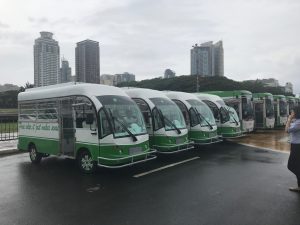
In the Philippines, Jeepneys (approximately 200,000 nationwide) are the most dominant form of public transport, accounting for around 40% of all motorised person trips in the Philippines, or estimated 40 million person trips/day. The Jeepney is also considered by many Filipinos as a cultural icon, and modernisation of this sector has been an uphill climb. This is now changing.
I was very much against the modernisation, but we have realised that it can benefit thousands in terms of jobs. This is a very good plan of our government. We now have many applicants and we will be able to help many people. Now I say, how can anyone say no to modernisation? The support we have received is outstanding, and we are very happy.
Joe Lawenko, Chairman at the Diamond Transport Service Cooperative

This change in mindset may be the reason why more than a thousand members from 22 transport cooperatives all over the region in Mindanao attended the Public Utility Vehicle Program (PUVMP) Roadshow on March 17, 2019. This has been recognized by the Department of Transportation as by far the “biggest one-day event” promoting the Public Utility Vehicle Modernisation Program, colloquially called the Jeepney Modernisation Program. The TRANSfer project, through support by the International Climate Initiative (IKI) supported the design and initial phase of the reform.
In his keynote speech, LTFRB Chairman Atty. Martin B. Delgra III, emphasized that the purpose of this government in all its efforts, is to give the Filipinos a comfortable life. And one way is through the modernisation of the Jeepney sector.
The plan of the government is to bring pollution levels down, because many of our old Jeepneys contribute to air pollution.
Edgardo Madelo, Jeepney Driver in Butuan City
And for many Filipinos, this is more than enough reason for the modernisation. The Department of Transportation in the Philippines has been continuously rolling out the implementation of its Public Utility Modernisation Program through stakeholder consultations and on-site visits throughout the country, bringing with them representatives from the vehicle manufacturers, development banks, as well as representatives of other government offices. They are set to roll-out around another 3000 new Jeepneys before the end of the year.
“Change is Coming” has been the campaign slogan of the incumbent government. And indeed, for the Philippine Jeepney, change has come.

You are currently viewing a placeholder content from X. To access the actual content, click the button below. Please note that doing so will share data with third-party providers.
More Information